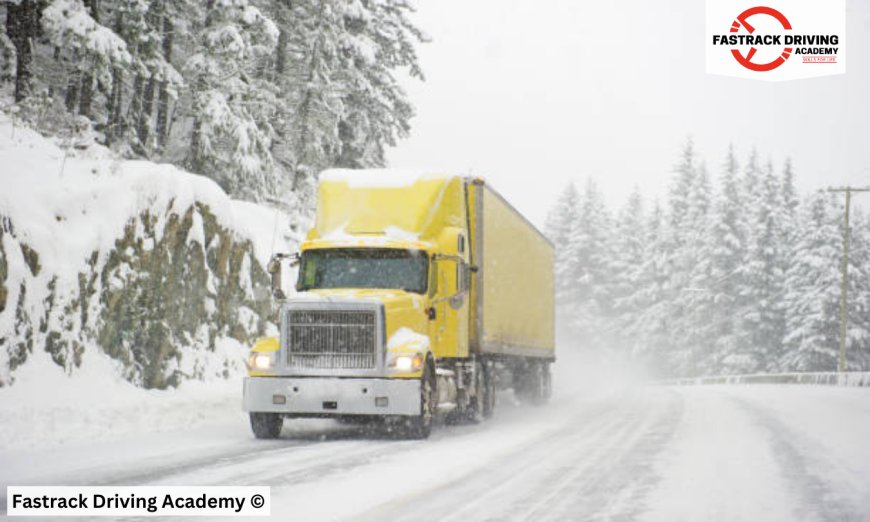How to Handle Tough Weather Conditions on the Road
Stay safe while driving in tough weather conditions with essential tips for commercial drivers. Learn how to adjust your speed, maintain following distance, and handle challenges like black ice and hydroplaning effectively.

Driving in tough weather conditions requires extra caution and preparedness, especially for commercial drivers. Inclement weather, such as rain, snow, fog, or ice, can drastically affect visibility, traction, and your ability to control the vehicle. Here’s how to handle challenging weather conditions safely:
1. Slow Down
In bad weather, speed can be your biggest enemy. Reduced visibility and slippery roads increase the risk of accidents. Adjust your speed to match the road conditions, even if it means going slower than the posted speed limit. By slowing down, you:
- Increase your reaction time to avoid sudden hazards.
- Maintain better control over your vehicle on slippery surfaces.
- Reduce stopping distance, which is critical on wet or icy roads.
2. Increase Following Distance
In severe weather, the stopping distance required for large vehicles increases dramatically. To avoid rear-end collisions:
- Double your normal following distance. Keep at least 8-10 seconds between you and the vehicle ahead.
- Stay alert for sudden stops or slowdowns by scanning the road ahead.
- Avoid tailgating to give yourself ample room to stop.
3. Use Low Beams in Fog and Heavy Rain
When visibility is reduced due to fog, rain, or snow, using your high beams can actually worsen the situation by reflecting light back at you. Instead:
- Use low beams to reduce glare and improve visibility.
- Turn on fog lights if your vehicle is equipped with them.
- Keep lights on during the day in bad weather so other drivers can see you.
4. Watch for Black Ice
Black ice is a thin, invisible layer of ice that forms on roads, making them extremely slippery. It often appears in shaded areas, on bridges, and in early mornings or late at night. To handle black ice:
- Avoid sudden movements, such as hard braking or sharp turns.
- Ease off the accelerator and allow the vehicle to slow down gradually.
- Gently steer the vehicle in the direction you want to go if you start skidding. Staying alert to temperature changes near freezing can help you spot potential ice patches.
5. Brake and Accelerate Gently
In tough weather, sudden braking or rapid acceleration can cause your vehicle to skid or lose control. To maintain safety:
- Brake slowly and gently to avoid locking your wheels on slippery surfaces.
- Use engine braking where possible, especially on steep hills or icy roads.
- Accelerate gradually to prevent your tires from spinning or slipping. Gentle control over your vehicle’s movements helps maintain traction and stability.
6. Avoid Hydroplaning
Hydroplaning occurs when your tires lose contact with the road surface and slide on a layer of water. This can happen during heavy rain or on roads with poor drainage. To prevent hydroplaning:
- Reduce your speed on wet roads.
- Avoid driving through large puddles whenever possible.
- Ensure your tires are properly inflated and have enough tread to channel water away. If you start to hydroplane, don’t panic—ease off the gas and steer straight until you regain control.
7. Use Chains or Snow Tires in Icy Conditions
In regions prone to heavy snow and ice, equipping your vehicle with chains or snow tires can drastically improve traction. Be sure to:
- Install chains or snow tires before setting off in extreme winter conditions.
- Follow local regulations for the use of snow chains, which may vary by location.
- Drive slowly with chains to avoid damage to the tires or the road.
8. Anticipate and Avoid Wind Gusts
High winds can be particularly dangerous for tall or heavily loaded commercial vehicles. Wind gusts may cause the vehicle to sway or even tip over in extreme cases. To mitigate the risks:
- Grip the steering wheel firmly to counteract wind gusts.
- Reduce speed to maintain control.
- Avoid driving in areas with high wind exposure, such as open plains, bridges, or mountain passes, during extreme weather.
9. Plan Routes Ahead
Before setting out, always check the weather forecast and adjust your route or timing if necessary. Bad weather can lead to road closures or hazardous conditions, so it’s essential to:
- Plan alternate routes that may have better road conditions.
- Avoid high-risk areas such as mountain roads during storms or snow.
- Monitor traffic updates for potential delays or dangerous stretches of road.
10. Stay Calm in Emergencies
In tough weather, emergencies like vehicle breakdowns or accidents are more likely to occur. Staying calm is key to handling these situations effectively:
- Pull over safely if you feel you cannot continue driving in extreme conditions.
- Turn on hazard lights to alert other drivers if you need to stop or are in distress.
- Stay in your vehicle if you’re stranded, especially in extreme cold, and contact emergency services for help.
Handling tough weather conditions as a commercial driver requires preparation, skill, and caution. By slowing down, maintaining a safe following distance, and using defensive driving techniques, you can navigate challenging weather safely. Always stay aware of changing road conditions, and don't hesitate to take breaks or adjust your route if necessary. Safety is the top priority.
What's Your Reaction?
































